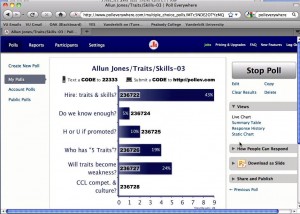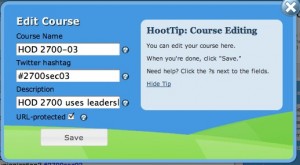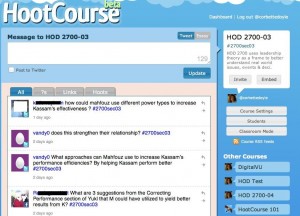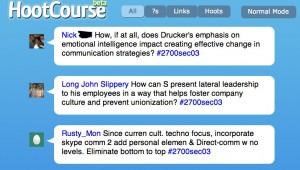Twitter as an Enabler of Critical Thinking
This is a guest post by Corbette Doyle, a Lecturer in Leadership, Policy & Organizations, and Steph Milne, her TA. In addition to her TA role, Steph recently earned her undergraduate degree and is currently a second-year graduate student in LPO.
This Thursday, October 20th, at 4:00 p.m., Corbette and Steph will be discussing their use of social media in teaching as part of Vanderbilt’s “DigitalVU” month. The session will be here at the CFT, and RSVPs are requested. Update: The discussion with Corbette and Steph can be viewed here.
The Problem
 Corbette (the Teacher): Ever teach a course you think is fascinating but the students don’t seem to agree? That’s where I found myself after last semester, so I decided to completely revamp my course on leadership. My goal? Find a pedagogy and/or tools that would increase critical thinking and student engagement. I settled on an approach featuring case studies, but knew that wasn’t enough to guarantee the lively discussions I envisioned.
Corbette (the Teacher): Ever teach a course you think is fascinating but the students don’t seem to agree? That’s where I found myself after last semester, so I decided to completely revamp my course on leadership. My goal? Find a pedagogy and/or tools that would increase critical thinking and student engagement. I settled on an approach featuring case studies, but knew that wasn’t enough to guarantee the lively discussions I envisioned.
 Steph (the Student): Coming from a large public university, with class sizes in the hundreds of students, I will be the first to admit that I have sat in class and not “heard” a single word the professor was saying. A passive, lecture-based class where attendance and participation are optional is just as dreary for professors as it is for students. Cases, although a viable solution to overcoming the passive lecture, are not a definite slam-dunk. For cases to be successful, students must actively link the case story to previous coursework and theories… admittedly, not all students make the connection.
Steph (the Student): Coming from a large public university, with class sizes in the hundreds of students, I will be the first to admit that I have sat in class and not “heard” a single word the professor was saying. A passive, lecture-based class where attendance and participation are optional is just as dreary for professors as it is for students. Cases, although a viable solution to overcoming the passive lecture, are not a definite slam-dunk. For cases to be successful, students must actively link the case story to previous coursework and theories… admittedly, not all students make the connection.
Solutions Identified
Corbette: A huge fan of the value of asking good questions (in the spirit of Ken Bain’s keynote at the CFT’s recent 25th anniversary), I decided to replace my prior “entrance ticket” strategy for the course (i.e. clicker questions on assigned readings) with a requirement that, before each class, the students post a question that applied course theory to the case to be discussed in that class. Students would then vote on the questions they wanted to tackle in class. My goals? Encourage higher order thinking by asking them to apply the readings in advance of the class—and engage them by giving them some control over the discussions.
The harder part was finding technology that met my goals without frustrating the students or me! I considered Turning Technologies newest clickers, which allow text-message-like responses; the discussion groups on OAK; and Twitter. All three had problems for my purposes—and then I came across a review of a Twitter application called HootCourse. Viola—solution identified!
I then tested several alternatives to clickers to allow the students to vote on their favorite questions by texting in the answer from their phone. I haven’t found the perfect solution yet, but am currently using Poll Everywhere, which is free for up to 30 respondents and accepts responses via text or web applications.
Steph: Having a course with an “entrance ticket” for every class is not the norm in undergrad. Reading the syllabus and seeing that you have to post a question on the readings before every class may initially seem daunting to students. Tweeting the questions though, certainly makes this task more appealing and accessible to students. At the end of the semester, I am positive students will understand the purpose of the “entrance ticket” and appreciate how much more they have learned because of it.
The discussion boards on OAK are difficult to navigate, particularly reading through posts in a sequential manner. For students, this makes it challenging to respond to posts. For a TA it makes it hard to mark the quality of discussion, as it is frequently disjointed. Public accountability is limited by the fact that students must click on their peer’s post to read it – the content is not readily available. HootCourse provides an easy-to-use platform and allows students to engage with course material through media tools with which they are already familiar.
A fair amount of classes use clickers to poll students. From what I’ve gathered, students are certainly not opposed to using clickers; they like to be engaged. However, it is an added cost and they have to remember to bring the clicker to class. Poll Everywhere has students text the answer. It is similar to a clicker but with one very important difference – have you ever seen an undergraduate student leave home without their cell phone?!
How it Works
Corbette: To get started, I logged into HootCourse using my Twitter account (Facebook is the other option) and clicked “create a new course.” This created a link I was able to copy and paste into OAK with instructions to log on via Twitter or Facebook. (Students can remain anonymous by creating a fictitious Twitter account and giving me that name.) Only students who have the link can access the HootCourse course site.
I post a topic on OAK and students have until 7:00 a.m. the day of class to post their questions as 140-character tweets. Steph then selects six tweets for each class, including some that address topics I want to discuss in class. I post those in class and students pull out their cell phones and vote via Poll Everywhere. The top three questions are the ones we discuss during class. At the end, I give a mini-lecture on any key topics we didn’t get to.
Steph: Selecting the tweets for discussion is a balancing act between choosing the most interesting and engaging tweets and ensuring all students have the opportunity to have their questions discussed. To ensure fairness, I read through all the tweets (once they have all come in at 7:00 a.m.) and note any tweets that stand out as discussion points for class, as well as any tweets that integrate and apply course material. When choosing tweets, I refer back to the lesson plan to ensure the selected tweets guide the class appropriately. I also grade the student tweets. Grades range from 0 (missing, plagiarized, unfamiliar with material) to 2.5 (excellent, above and beyond). Most students demonstrate critical thinking and average a grade of 2 (expected). The tweets chosen for discussion often receive the highest grades.
Why it Works/the Benefits
Corbette: HootCourse offers several advantages that make it attractive for classroom use including the following: a view of all tweets that end in question marks, a “Students” dashboard that tracks activity by student, and a “Classroom Mode” that is perfect for projecting tweets real-time in class (ideal for a backchannel strategy).
For the most part, I am impressed with the caliber of the questions tweeted. The students are very clearly applying theory to the cases and thinking critically about the issues involved. This is equally clear in the in-class discussions where the students seem far more engaged and fairly adept at linking material from multiple sources in order to support their positions. And I almost always have to cut the discussion off before students have run out of comments.
Steph: Students are talking about tweeting for class – they are talking with their friends, their parents, and their fellow classmates. I have heard from multiple students that they think its “cool” that they not only get to use their cell phones in class, but they get to use social media (Facebook and Twitter) for educational purposes! The perception is that Professor Doyle “gets them.” This increased engagement from students translates into a higher quality of work and critical thinking.
HootCourse, as a platform, allows all students in the course to view the other tweets. This transparency holds students accountable to each other, and subsequently increases the quality of the tweets. Students are clearly holding each other accountable in class to answer the questions they posed. One afternoon, a student was called on to answer his own tweet and half the class turned to him and made comments along the lines of, “Yeah… come on… you try to answer that question!” This demonstrates how closely students read their peers’ posts and their increased level of engagement.
Hurdles & Solutions
Corbette: My biggest disappointment is that HootCourse does not yet allow students to “like” other tweets. My original plan was to have students “like” three other tweets. Those with the most votes would be the ones we discussed in class, which would make the technology easier to use without the support of a TA.
The biggest disadvantage of the free version of Poll Everywhere is that it does not allow you to track votes, thus you don’t have the option of using it for attendance or for graded questions. I may consider upgrading in the future as I also have classes with more than 30 students.
Steph: There have been students who have “re-tweeted” previously posted questions in slightly different words, but this is not a shortcoming of HootCourse itself. Plagiarism is a challenge that comes with engaging students in any public domain.
For those students who do happen to leave home without their cell phone (on the rare occasion), Poll Everywhere allows students to email in answers. The hope being, students carry at least one internet-capable device with them to class.
Assessment & Next Steps
Overall: The strategy seems to achieve the desired critical thinking results given the quality of class discussions. The results of the first quiz are less exemplary, however, with grades approximating a bell curve—which isn’t necessarily a negative outcome.
Concerns: What happens without a TA or in large classes? The option to “like” or “retweet” in HootCourse – as discussed above would be a partial solution. Using Twitter without HootCourse but with class-specific hashtag, is another option, one that would support retweets. Unfortunately, it would lose the narrowed focus of tweets the students get to vote on.
Next Steps: HootCourse is one option that facilitates an ongoing digital dialogue during the class. This backchannel capability seems to be a better alternative for large classrooms where it isn’t possible to allow all students to voice their thoughts, as a strategy to allow the more reticent students to voice their opinions, and/or as a way for groups to post updates during and outside of class.
We occasionally feature guest posts here on the blog as part of our efforts to cultivate dialogue about teaching and learning among Vanderbilt faculty, students, and staff. We recognize that everyone’s teaching context is different, but we hope that hearing others’ perspectives on teaching and learning will help our readers reflect on their own teaching. If you would like to contribute a guest post, please let us know.






Leave a Response